Discover the intriguing world of the titan arum (Amorphophallus titanum), commonly referred to as the corpse flower. This extraordinary herbaceous plant belongs to the arum family (Araceae) and is renowned for its remarkable size and strong odor emitted by its inflorescence.
Native to the steep hillsides of western Sumatra’s rainforests, the titan arum has captured the interest of botanic gardens worldwide due to its distinctiveness.
Its infrequent blooming periods and unique features, including its captivating scent, have turned it into a fascinating attraction for enthusiasts.
The titan arum boasts a fascinating flower structure, featuring a central flower spike known as a spadix, surrounded by a collar-like structure called a spathe. The spathe, typically green to cream-colored on the outside, opens up to reveal an intriguing interior.
| Taxonomic Rank | Classification |
|---|---|
| Kingdom | Plantae |
| Division | Magnoliophyta |
| Class | Liliopsida |
| Order | Alismatales |
| Family | Araceae |
| Genus | Amorphophallus |
| Species | titanum |
What is a Corpse Flower?
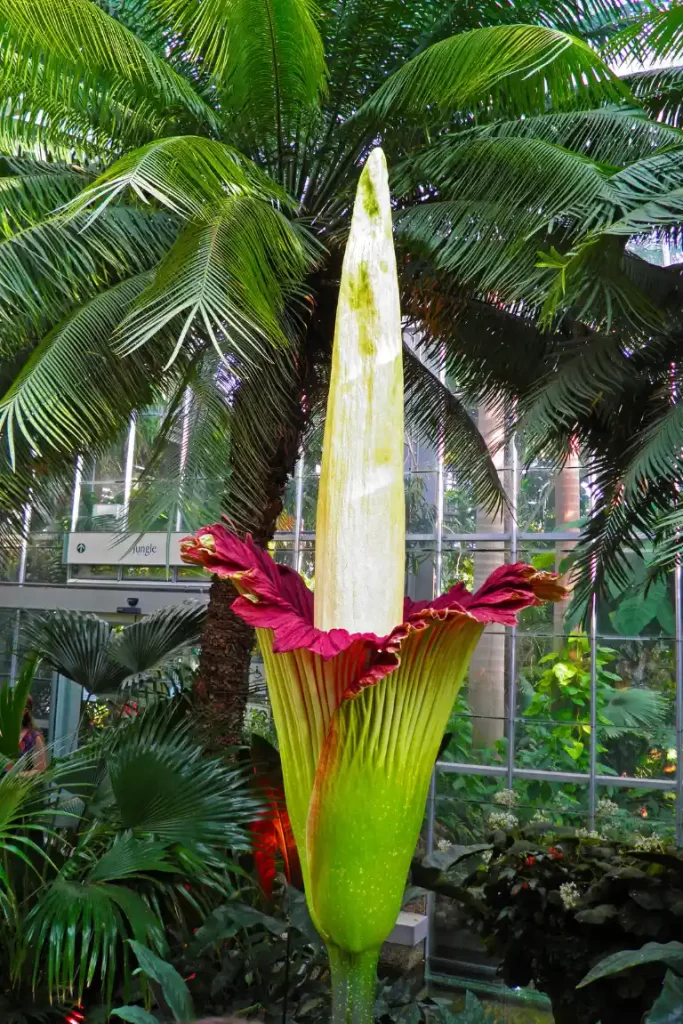
Corpse Flower, scientifically known as Amorphophallus titanum, is an intriguing and extraordinary flowering plant that captivates the imagination with its massive size and peculiar characteristics.
Let’s delve into the fascinating world of the Corpse Flower and explore its unique features, including its distinct odor, size, blooming cycle, and botanical significance.
Description: A Spectacle of Nature
The Corpse Flower, or Titan Arum, belongs to the Araceae family and stands as a botanical marvel. With its impressive stature and distinct appearance, this plant commands attention wherever it blooms.
It features a remarkable flower structure consisting of a central flower spike called a spadix, surrounded by a large collar-like structure known as a spathe. The spathe, often green to cream-colored on the outside, opens to reveal an intriguing interior.
Size: A Giant Among Flowers
One of the most remarkable aspects of the Corpse Flower is its exceptional size. It holds the title for having the largest unbranched inflorescence among all flowering plants.
The entire structure can reach towering heights of over three meters (9.8 feet), making it an awe-inspiring sight to behold. This colossal size adds to the plant’s allure and contributes to its reputation as a botanical wonder.
Flower: A Fragrant Phenomenon
One of the distinguishing characteristics of the Corpse Flower is its strong and distinct odor. When in bloom, the plant emits a putrid scent resembling rotting flesh.
This foul aroma serves a vital purpose in nature by attracting carrion beetles and flesh flies, which act as pollinators. While the scent may be off-putting to human noses, it is an irresistible lure for certain insects that aid in the plant’s reproduction.
Botanical Significance: A Natural Marvel
The Corpse Flower holds great botanical significance due to its unique characteristics and limited distribution. It is native to the rainforests of western Sumatra, where it thrives in the challenging and diverse ecosystem.
The plant’s captivating features, including its immense size and distinctive odor, have made it an object of scientific study and botanical curiosity. Additionally, its infrequent blooming events often attract significant attention from botanic gardens, researchers, and plant enthusiasts around the world.
The Corpse Flower, or Amorphophallus titanum, stands as a captivating marvel of the botanical world. Its exceptional size, foul odor, rare blooming cycle, and botanical significance contribute to its allure and make it a subject of fascination for scientists and nature lovers alike.
The chance to witness the Corpse Flower in bloom is a rare and extraordinary opportunity to witness the wonders of nature firsthand.
Origin and Native Habitat of the Corpse Flower
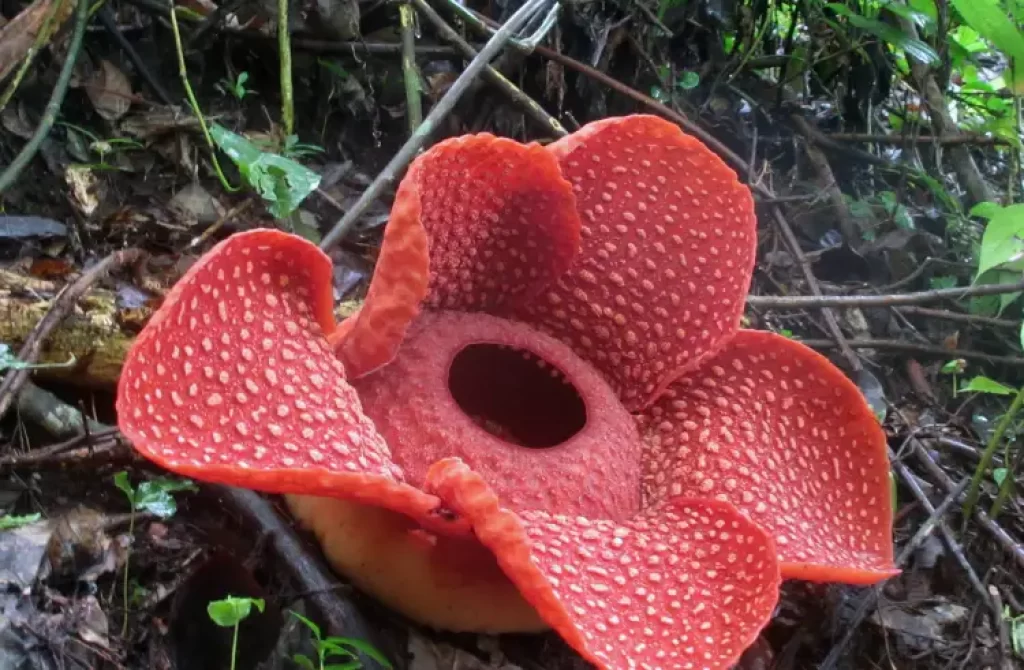
The Corpse Flower, scientifically known as Amorphophallus titanum, originates from the lush rainforests of western Sumatra, an island located in Indonesia. This captivating plant has adapted to thrive in the unique environmental conditions found in this region.
Rainforests of Western Sumatra: A Biodiverse Haven
The rainforests of western Sumatra provide the ideal habitat for the Corpse Flower. These forests are known for their rich biodiversity and serve as home to countless plant and animal species. The humid climate, ample rainfall, and nutrient-rich soils create the perfect conditions for the growth and survival of this remarkable plant.
Steep Hillsides: Nature’s Challenging Terrain
Within the rainforests of western Sumatra, the Corpse Flower specifically thrives on the steep hillsides. These sloping landscapes present a challenging terrain, characterized by variable moisture levels and limited access to sunlight. However, the Corpse Flower has adapted to these conditions and has developed unique survival strategies to thrive in such environments.
Endemic to Western Sumatra: A Geographical Restriction
The Corpse Flower is endemic to the rainforests of western Sumatra, meaning it is naturally found only in this specific region. Its distribution is limited to certain areas within the rainforest, where the environmental factors align to support its growth and reproductive cycle. This endemism adds to the plant’s ecological significance and makes it a distinct and treasured part of the region’s biodiversity.
Conservation and Cultivation: Extending Its Reach
While the Corpse Flower is native to western Sumatra, its captivating characteristics have drawn attention from around the world. In efforts to conserve and study this remarkable plant, it is cultivated in botanic gardens and research institutions worldwide.
By cultivating the Corpse Flower outside its native habitat, scientists and botanists can gain valuable insights into its biology, reproductive processes, and ecological role.
The Corpse Flower, or Amorphophallus titanum, finds its roots in the rainforests of western Sumatra, Indonesia. This region’s unique climatic conditions and diverse ecosystems provide the ideal home for this extraordinary plant.
While its native range remains restricted to the steep hillsides of this area, cultivation efforts have extended its reach to botanic gardens globally, allowing people worldwide to marvel at the beauty and wonder of this captivating species.
Why is it called the Corpse Flower?
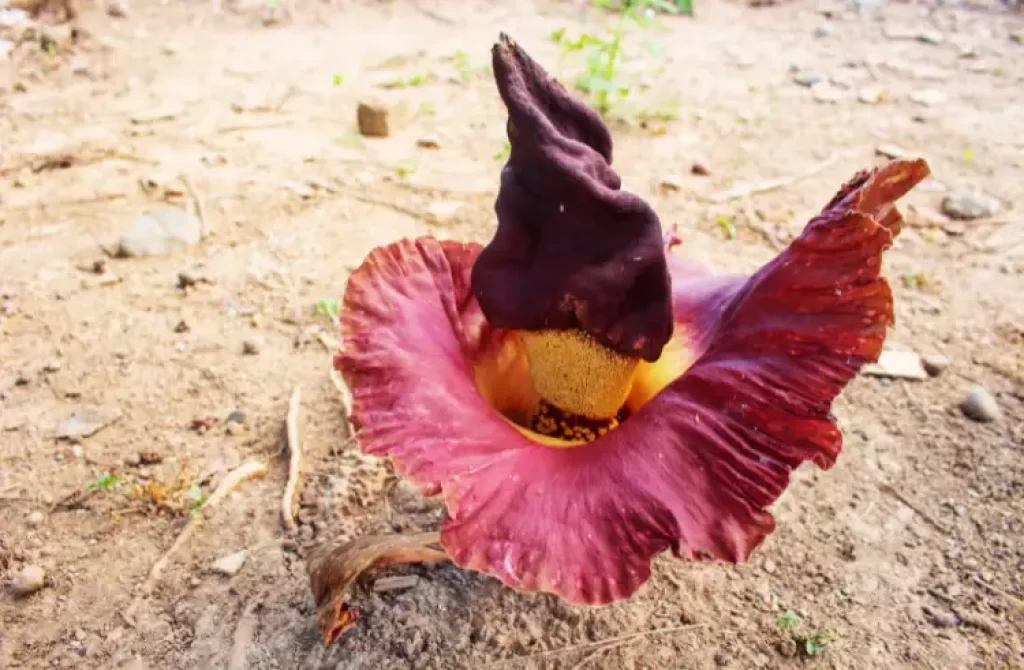
The Corpse Flower earned its intriguing name due to its distinctive and rather unpleasant odor, which resembles the scent of rotting flesh.
This pungent smell is often compared to that of a decomposing corpse, hence the name “Corpse Flower.” The purpose behind this foul odor is actually a clever adaptation for the plant’s survival.
By emitting such a strong scent, the Corpse Flower attracts carrion beetles and flesh flies, which are natural pollinators that typically feed on decaying matter. These insects are lured to the flower, believing it to be a suitable food source, and inadvertently aid in the pollination process.
Despite its unconventional aroma, the Corpse Flower’s unique scent has contributed to its fame and intrigue among botanists, horticulturists, and curious observers worldwide.
Life Cycle of a Corpse Flower: From Dormancy to Blooming
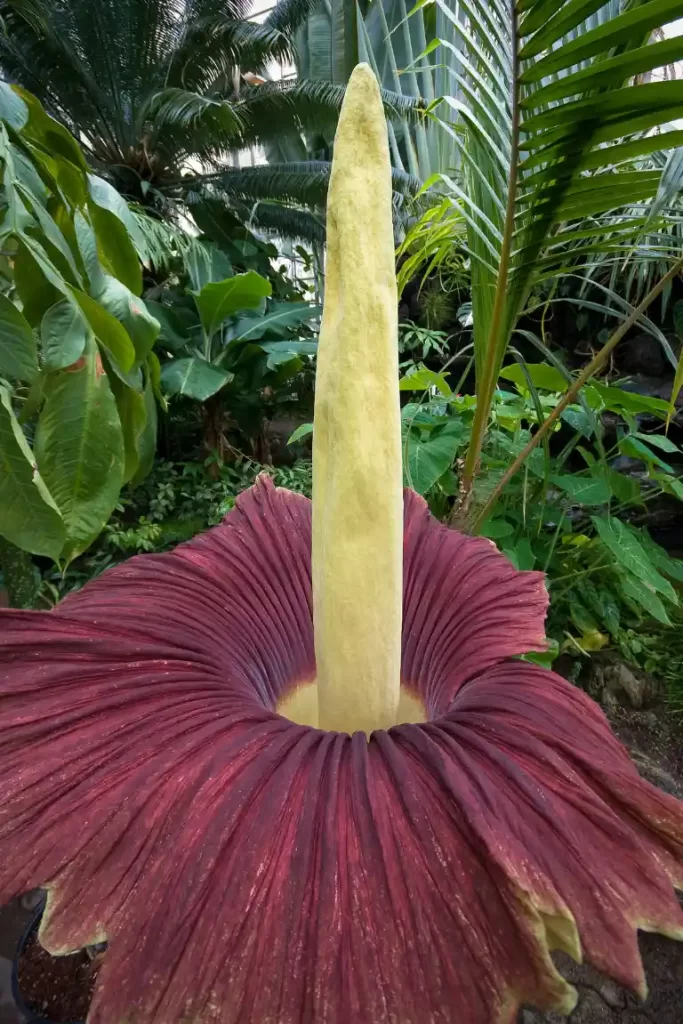
The life cycle of a Corpse Flower, scientifically known as Amorphophallus titanum, is a fascinating journey that captivates botany enthusiasts and curious observers. Now let’s explore the different stages of its life cycle, from dormancy to blooming.
Note: When the time comes, the plant rapidly grows, sometimes reaching an astonishing rate of up to 15 centimeters (6 inches) per day.
Dormancy
During the dormancy period, the Corpse Flower remains in an inactive state, with its energy stored in an underground corm, a large tuber-like structure.
The plant withdraws its above-ground parts, such as leaves and flowers, and conserves energy. This period can last for several months or even years, as the plant prepares for its next blooming event.
Vegetative Growth
After the dormancy period, the Corpse Flower enters the vegetative stage, where it focuses on growing leaves and roots. This stage can span several years, as the plant accumulates energy and nutrients to support future blooming. The leaves are large and compound, consisting of several leaflets radiating from a central stalk.
Inflorescence Formation
The most remarkable aspect of the Corpse Flower’s life cycle is the formation of its massive inflorescence, which includes the blooming flower. The development of the inflorescence is a complex process that requires specific environmental conditions and sufficient stored energy within the corm.
Blooming
The blooming stage is the highlight of the Corpse Flower’s life cycle. The inflorescence emerges from the soil, revealing the striking flower structure encased in a large collar-like structure called a spathe.
The spathe is often green on the outside and can display vibrant colors on the inside, ranging from deep crimson to purple.
The blooming period of a Corpse Flower is relatively short, typically lasting around 24 to 48 hours.
During this time, the flower reaches its maximum size and emits its notorious odor, resembling the scent of rotting flesh. The strong odor serves as an attraction for carrion beetles and flesh flies, which aid in pollination.
Fruit Development and Dispersal
After pollination, the fertilized flowers of the Corpse Flower develop into bright red to orange spherical fruits. These fruits contain seeds that will eventually be dispersed to new locations.
The spathe and the upper part of the inflorescence collapse, revealing the fruits, which are eagerly sought after by animals like rhinoceros hornbills and other fruit-eating creatures.
Through their feeding and subsequent dispersal, these animals contribute to the plant’s reproductive success.
Dormancy
Following the blooming and fruiting stage, the Corpse Flower enters another period of dormancy. The above-ground parts wither away, and the plant retreats underground, relying on the stored energy within the corm to sustain it until the next blooming cycle.
The intermittent blooming, extended dormant periods, and remarkable flower structure make the life cycle of the Corpse Flower a truly captivating natural phenomenon. Each blooming event is eagerly awaited and celebrated, attracting visitors from around the world to witness this extraordinary botanical spectacle.
How often does the Corpse Flower bloom?
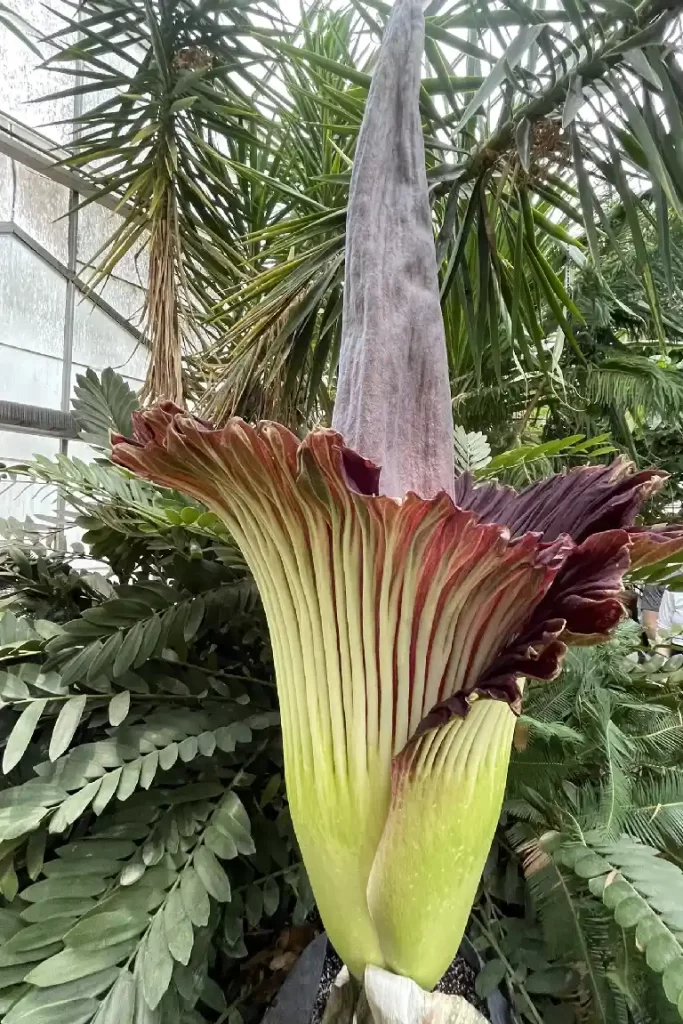
The blooming frequency of the Corpse Flower, also known as Amorphophallus titanum, can vary and is influenced by several factors. Let’s explore the blooming patterns of this intriguing plant:
Irregular Blooming Intervals:
The Corpse Flower is known for its irregular blooming intervals, and it typically does not bloom annually like many other flowering plants. Instead, it follows a sporadic and unpredictable blooming schedule.
In most cases, the plant requires several years of growth before it reaches maturity and produces its first bloom. This initial bloom can take anywhere from 4 to 10 years or even longer, depending on various environmental conditions and the overall health of the plant.
Long Periods Between Blooms:
Once the Corpse Flower has bloomed for the first time, it generally enters a period of dormancy before producing subsequent blooms. This dormancy period can last for several years, typically ranging from 2 to 7 years. During this time, the plant focuses on replenishing its energy reserves and growing underground structures that support future blooming.
Major Event When in Bloom
When the Corpse Flower finally blooms, it becomes a major event due to its rarity and unique characteristics. The blooming process itself is relatively short-lived, typically lasting between 24 to 48 hours.
This brief window is when the distinct fragrance and impressive appearance of the inflorescence are at their peak. The Corpse Flower’s bloom often attracts considerable attention from botanists, horticulturists, and curious visitors, leading to increased interest and public engagement.
What is the purpose of the foul odor emitted by the Corpse Flower?
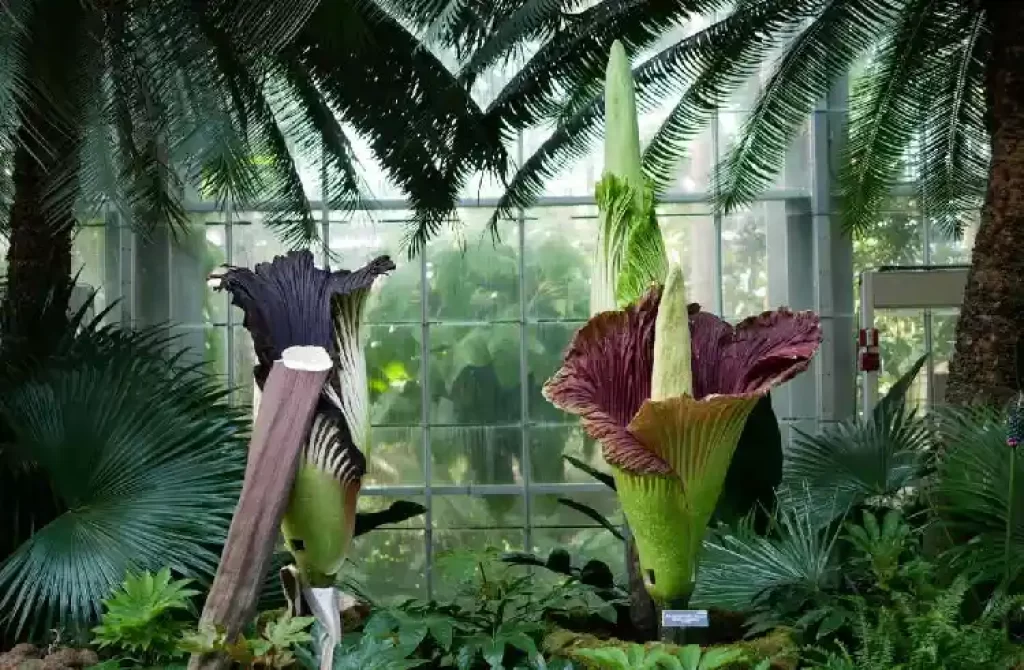
he distinctive foul odor emitted by the Corpse Flower serves an important purpose in its reproductive strategy. Let’s take a look at the significance of this unique scent in more detail:
1. Attracting Pollinators:
The primary role of the Corpse Flower’s foul odor is to attract specific pollinators, such as carrion beetles and flesh flies. These insects are naturally drawn to the scent of decaying organic matter, including rotting flesh.
The Corpse Flower takes advantage of this preference by producing a scent that closely resembles the odor of decomposing animal carcasses. This strong and repugnant fragrance acts as a powerful attractant, guiding these insects to the flower.
2. Facilitating Pollination:
When carrion beetles and flesh flies are lured to the Corpse Flower’s inflorescence by its scent, they inadvertently become instrumental in its pollination process. As these insects visit the flower, they come into contact with the male and female reproductive structures.
Pollen from the male flowers sticks to their bodies as they feed on the flower’s resources. When they move on to another Corpse Flower, they inadvertently transfer this pollen to the female flowers, allowing for fertilization to occur and the production of seeds.
3. Specificity of Pollinators:
The Corpse Flower has evolved to rely on specific pollinators, such as carrion beetles and flesh flies, for successful pollination. The distinct odor it emits specifically targets these insects, ensuring that only the appropriate pollinators are attracted.
By attracting carrion beetles and flesh flies, the Corpse Flower maximizes its chances of successful pollination, as these insects are well-suited to carry and transfer its pollen.
This specificity also helps maintain genetic diversity within the population, as the flowers are more likely to receive pollen from other Corpse Flowers, rather than self-pollination.
In summary, the foul odor emitted by the Corpse Flower is a specialized adaptation aimed at attracting specific pollinators. By producing a scent that mimics the smell of decaying flesh, the flower successfully lures carrion beetles and flesh flies, facilitating pollination and ensuring the continuation of its species.
Botanic gardens or locations where the Corpse Flower can be observed

The Corpse Flower, scientifically known as Amorphophallus titanum, is a rare and captivating plant that attracts attention wherever it blooms. While it is primarily native to the rainforests of Sumatra, Indonesia, the plant has also found its way to several botanic gardens and other locations worldwide. Here are some notable places where you may have the opportunity to observe the Corpse Flower:
Royal Botanic Gardens, Kew (London, UK)
The famous botanic gardens in London have successfully cultivated and showcased the Corpse Flower on multiple occasions, drawing large crowds eager to witness its blooming.
Huntington Library, Art Collections, and Botanical Gardens (California, USA)
The Huntington Gardens in San Marino, California, have cultivated Corpse Flowers that have bloomed several times, providing visitors with a chance to experience this extraordinary plant up close.
United States Botanic Garden (Washington, D.C., USA)
Located on the grounds of the U.S. Capitol, the Botanic Garden has displayed blooming Corpse Flowers, attracting enthusiasts and curious onlookers who want to witness this remarkable natural spectacle.
Chicago Botanic Garden (Illinois, USA)
The Chicago Botanic Garden has successfully cultivated Corpse Flowers that have bloomed periodically, offering visitors a chance to see and smell the awe-inspiring inflorescence.
Singapore Botanic Gardens (Singapore)
This renowned botanic garden has played a significant role in the conservation and cultivation of various plant species, including the Corpse Flower. The Gardens’ efforts have resulted in successful blooming events that have captivated locals and tourists alike.
Bergius Botanic Garden (Stockholm, Sweden)
The Corpse Flower has bloomed multiple times at the Bergius Botanic Garden, providing an opportunity for plant enthusiasts in Sweden to experience the mesmerizing and unique traits of this plant.
It’s important to note that the Corpse Flower’s blooming is unpredictable, and the specific locations where it can be observed may vary over time. Therefore, it is advisable to check with the respective botanic gardens or botanical institutions for any upcoming Corpse Flower bloom events or displays.
Medicinal Uses and Traditional Folklore Associated with the Corpse Flower
The Corpse Flower, scientifically known as Amorphophallus titanum, is primarily renowned for its captivating appearance and repugnant odor. While its main allure lies in its botanical curiosity, there are some intriguing traditional uses and cultural significance associated with this remarkable plant. It is important to note that these uses are based on traditional knowledge and should be approached with caution, as scientific research on their efficacy and safety is limited.
Traditional Medicinal Uses
In certain regions where the Corpse Flower is native, such as parts of Sumatra, the tubers of Amorphophallus titanum have been utilized in traditional medicine.
The tubers are believed to possess medicinal properties and have been employed for various purposes.
They have been used to alleviate digestive issues, treat skin conditions, reduce inflammation, and even as an aphrodisiac. However, it is crucial to emphasize that these traditional uses lack scientific validation, and caution should be exercised when considering any medicinal applications of the plant.
Ethnobotanical Significance
The Corpse Flower holds cultural and symbolic value in some indigenous communities. It has been integrated into local folklore, rituals, and spiritual practices.
The plant’s imposing stature, fascinating floral structure, and intense odor have contributed to its mythological significance.
It may be associated with stories, beliefs, or ceremonies that reflect the awe-inspiring nature of the plant. While these cultural and ethnobotanical aspects add depth to the appreciation of the Corpse Flower, they should be understood within their respective cultural contexts and not as evidence of its medicinal properties.
Closely Related Species to the Corpse Flower
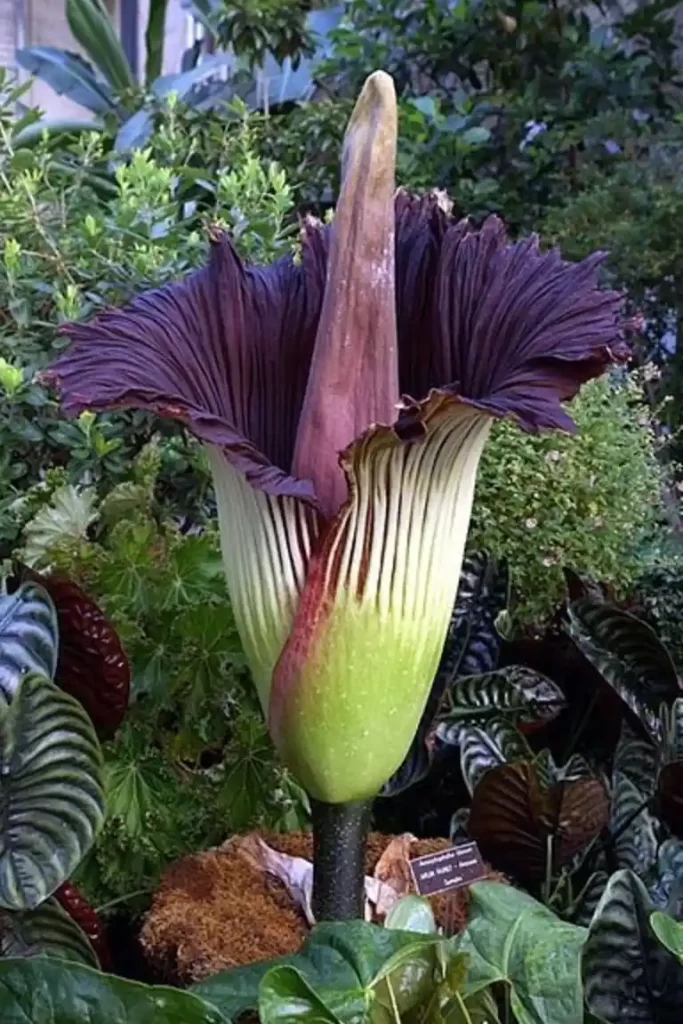
The Corpse Flower, scientifically known as Amorphophallus titanum, belongs to the genus Amorphophallus, which encompasses several other fascinating plant species. While the Corpse Flower is undoubtedly the most famous and iconic member of the genus, there are other species that share similar characteristics and captivating traits. Here are a few notable species closely related to the Corpse Flower:
Amorphophallus paeoniifolius
Also known as the Elephant Foot Yam or Whitespot Giant Arum, this species shares the same genus as the Corpse Flower. Native to tropical and subtropical regions of Asia, it features large, palmate leaves and produces an inflorescence that is smaller in size compared to the Corpse Flower but still noteworthy in appearance.
Amorphophallus konjac
Commonly referred to as Konjac or Devil’s Tongue, this species is native to East Asia. It is known for its starchy corm, which is used in culinary applications and also has medicinal properties. The Konjac plant produces a single, impressive flower that, although not as large as the Corpse Flower, displays a similar intriguing floral structure.
Amorphophallus bulbifer
Native to Southeast Asia, this species is often called the Voodoo Lily or Stink Lily. It is characterized by its distinctive, ornamental foliage and produces a spadix enclosed by a spathe. While smaller in size compared to the Corpse Flower, the Voodoo Lily also emits a pungent odor to attract pollinators.
Amorphophallus gigas
Native to the rainforests of Borneo, this species is known for its massive leaf size and unique floral structure. It produces a large inflorescence with a distinct scent.
Amorphophallus titanum var. gigas
This variety of the Corpse Flower is native to Sumatra and is a subspecies of Amorphophallus titanum. It shares similar characteristics with the Corpse Flower but may have some variations in size and appearance.
These are just a few examples of species closely related to the Corpse Flower within the Amorphophallus genus. Each species possesses its own unique characteristics and contributes to the diversity and intrigue of the group.
You might also like
- All About Common Sunflowers
- Growing Frangipani in Pots
- Welwitschia mirabilis: The Living Fossil of the African Desert
- Growing Japanese Maple: Care Tips & Cultivars
FAQ
Why are the titan arum flowers so big?
The titan arum flowers are exceptionally large to attract specific pollinators, such as carrion beetles and flies, by emitting a strong odor resembling rotting flesh. The size increases the visibility and spread of the scent, maximizing the chances of attracting pollinators over a greater distance.
Additionally, the large size accommodates a significant number of individual flowers, allows for efficient pollen transfer, and helps the flowers stand out amidst the dense rainforest vegetation, providing a competitive advantage.
Can you eat titan arum?
While it is technically possible to eat titan arum, it is not a common practice or recommended for consumption. The plant’s large corm (underground stem) contains calcium oxalate crystals, which can cause irritation and a burning sensation in the mouth and throat. The foul odor emitted by the flower also makes it unappealing for culinary purposes. Titan arum is primarily cultivated for its unique and impressive appearance rather than as a food source.
Is titan arum poisonous?
The titan arum (Amorphophallus titanum) is not considered highly toxic or deadly. However, certain parts of the plant, particularly the corm (underground stem) and the sap, contain calcium oxalate crystals, which can cause irritation and discomfort if ingested.
The crystals can irritate the skin, mucous membranes, and digestive system, leading to symptoms such as burning or stinging sensations, swelling, and gastrointestinal distress. It is important to exercise caution and avoid direct contact or consumption of titan arum to prevent any potential adverse reactions.






